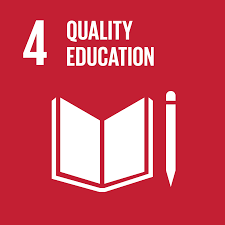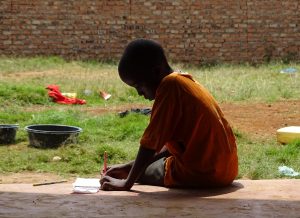Despite numerous international agreements proclaiming universal rights of education, street children do not fully enjoy these rights. We begin to commemorate Global Goals Week by looking at the Sustainable Development Goal (SDG) Goal 4. 
According to recent estimates, Covid-19 has wiped out 20 years of education gains. One year into the pandemic, two-thirds of students worldwide are still affected by complete or partial school closures. The most vulnerable children, like street-connected children, are at increased risk of never accessing school. Against this backdrop, efforts must be redoubled to make the indicators of Goal 4 to ensure inclusive and equitable quality education and promote lifelong learning opportunities for all a reality.
The right of all children to education is not only goal number 4 of the 2030 Agenda, but it is laid down in the Convention on the Rights of the Child and other international treaties and declarations that require free and compulsory primary education for all children. However, in the face of the Covid-19 education crisis, there is a greater risk that street-connected children are more likely to be forgotten by education systems that were already slow and inefficient in meeting the indicators that promised not to let education gaps widen.
What Goal 4 stands for
SDG 4 wants to “ensure inclusive and equitable quality education and promote lifelong learning opportunities for all”.
SDG 4 has seven objectives, three means of implementation, and twelve indicators. Eight of them are expected to be completed by 2030, and the rest do not have specific projected years for their competition. The goal seeks to deliver children and young people with a high-quality education that is easily accessible and has additional learning possibilities. The learning environment is an essential factor in developing knowledge and valuable capabilities. As a result, there is also a great need to build additional educational facilities and improve existing ones.
While efforts are being made, there are no apparent mechanisms that can provide more tailored solutions for street-connected children to access educational services in the foreseeable future. Even in countries where children’s overall level of schooling has increased, the quality gap in education persists, resulting in poor educational outcomes. Recent years have seen significant progress in improving access to education at all levels and increasing enrolment rates for women and girls. However, progress has also been problematic in developing regions due to high poverty levels, armed conflict, and other emergencies. Conditions of extreme poverty, exclusion and isolation do not bode well for sustainable, multicultural education programmes for street-connected children.
As we approach 2030, we see the scale and urgency of the challenge ahead. It is estimated that between 75 and 80 per cent of the indicators relevant to children in each country lack sufficient data or show insufficient progress. Data on Goal 4 in many developing countries are not available for a variety of reasons. With little data on some of the world’s most vulnerable children, such as those living in institutions or on the streets, there is a risk that they will not be given the most appropriate educational attention. Regardless of the reason, the lack of data constrains countries’ efforts to achieve the SDGs. The SDGs’ guiding principle of leaving no one behind requires looking beyond national averages to see which children and communities are not being served.
Achieving SDG 4 helps to accomplish other SDGs which are of particular interest to CSC such as ending child labour (SDG 8) and promoting peaceful societies (SDG 16) and simultaneously tying into our IDSC (International Day of Street Children) theme of access to service.
Why can’t street children access education?
 There are multiple factors that street children have expressed as reasons preventing them from accessing education. One of the main ones is the discrimination they face as a widely stigmatised minority group. Discrimination against street children leads to an inability for them to access to the education services they are entitled to in principle and by right. This discrimination is evident because they are prohibited from registering for lack of papers such as birth certificates, thus keeping them away from educational services. Dropping out of school because they do not have identity papers is a situation that is not strictly up to them and for which they are subject to discrimination.
There are multiple factors that street children have expressed as reasons preventing them from accessing education. One of the main ones is the discrimination they face as a widely stigmatised minority group. Discrimination against street children leads to an inability for them to access to the education services they are entitled to in principle and by right. This discrimination is evident because they are prohibited from registering for lack of papers such as birth certificates, thus keeping them away from educational services. Dropping out of school because they do not have identity papers is a situation that is not strictly up to them and for which they are subject to discrimination.
Street children are more likely to arrive at school hungry, sick, and tired. They are often bullied because of the cultural bias in schools and discrimination from teachers, parents, and peers. This leads to underachievement’s, dropouts, and social exclusion. Street girls face specific challenges related to gender discrimination and hostile attitudes from social groups who see it as unacceptable to claim their right to education, making them more likely to become targets of school abuses and violence. Another common situation that occurs, according to NGO reports, is that street children are easily blamed without evidence for crimes or vandalism due to stereotypical backgrounds, thus creating misconceptions about them that are detrimental to their well-being.
Another obstacle to school is attend the established school hours/ timetables. Children and adolescents who live on the street need to work or do paid work to survive, making it impossible for them to go to school and at the same time do something to earn money. Some street-connected children do not want to return to a school environment’s restrictive structure and supervision after living independently. Having spent time on the street, they may be far older than others of the same education level and may not be permitted to be in class with younger students. Besides the need to stay on their own, another major obstacle is the lack of means to cover the requested requirements and materials, which are additional expenses they cannot afford.
Often education is irrelevant for them. Street students will often find that the state’s education promotes a somewhat toxic climate rather than community-based mutual help and support environment where they can express themselves freely. They might feel that educational institutions do not teach them survival and work skills relevant to them. In many cases, the teaching available is seen as meaningless to their needs. Moreover, they might find it hard to build meaningful relationships with their peers or teachers compared to the strong bonds they have created in the streets.
Benefits of education for street-connected children
Education is the basis for community development and an indispensable tool to break the cycles that push street children into poverty and violence. Equitable, inclusive, and quality education improves the future of street-connected children and young people. Furthermore, education is widely recognised as a vehicle for accessing better economic and employment benefits by empowering individuals and providing the skills and values needed to cope with the everyday tasks of life through the socialisation it fosters.
The education and schooling of girls and boys is undoubtedly an essential factor in the well-functioning and well-being of all societies. Failure to provide primary education for all children to acquire the ability to read and write violates a universal right, and the long-term effects are devastating. This violation results in children being limited in their ability to know and access their individual rights and actively engage in the pursuit of collective ownership.
In the case of street children, education represents a possible social reintegration that brings multiple positive factors into their lives, from gradual acceptance by their classmates to the knowledge of their rights and the means to access them. When the environment is favourable and friendly in schools and educational institutions, it is a place where street children can feel like children, be curious, grow and develop safely without feeling less worthy than other children.
Education is one of the main drivers of sustainable development to improve people’s lives. We must realise that without the inclusion of street-connected children in educational settings, the next generations will continue to exclude them, and their families and problems will remain unresolved. Even with the barriers to educational access they face, street children interested in continuing their studies have always been motivated and interested in doing so despite challenging conditions. Recent footages and stories in social media of street children studying remotely with borrowed devices or in public spaces show that even during a pandemic, their desire to learn is stronger.
What can we do to meet the SDG 4 goal?
It is necessary to provide alternatives so that street children and adolescents ca n re-enter the school system. It is essential to speed up identity paperwork and allow the issuing of birth certificates for this population, in this way avoiding discrimination against a population that, due to their situation of family distance and lack of belongings, does not have any documents or a large part of them. In addition, there is a need for specialised teachers with the appropriate awareness training who understand the problems and the reality of street children to create a trusting and stable relationship between the two and allow the children to complete as many grades as possible.
n re-enter the school system. It is essential to speed up identity paperwork and allow the issuing of birth certificates for this population, in this way avoiding discrimination against a population that, due to their situation of family distance and lack of belongings, does not have any documents or a large part of them. In addition, there is a need for specialised teachers with the appropriate awareness training who understand the problems and the reality of street children to create a trusting and stable relationship between the two and allow the children to complete as many grades as possible.
The various existing indicators for measuring the progress of the educational processes of street children and adolescents should be redesigned. Approaches must be reformulated, and street-connected students must be considered successful when they remain in school and not so much value should be given to their school performance. Long-term retention by schools of street-connected children shows improvements in the system that previously failed to retain them. The children have persevered and are resilient with strong determination even without a capable system.
Interestingly, General Comment 21 reminds us that, concerning educational services for street children that “States are the primary duty-bearers [;] civil society activities may complement States’ efforts in developing and delivering innovative and personalised service provision.” Governments are responsible for generating the data that will guide and measure the achievement of SGD Goal 4. And it is our collective responsibility to support them in their strong points and demand that the gaps be corrected.
So far, there are no common mechanisms that introduce more personalised reintegration guidelines into the educational system for street-connected children. We must continue to push for more tailored systems to be created and make accessible education for all. It is essential to understand the decisive role that education and lifelong learning opportunities play for street-connected children. We must continue to promote partnerships, alliances, and support networks between civil society, governmental bodies, and NGOs working with and for street-connected children. Exchanges of views and the resulting strategies for action make it possible to provide mutual support to solve problems and give continuity to projects promoting education. Moreover, they enable the children’s rights-based approach to education to be encouraged, thus contributing to their understanding of their rights.
The reintegration of street children needs specific intervention strategies. Some changes that we consider could be introduced in the national educational plans include:
- The establishment of support groups between educators and former street children who have direct experience with educational settings and thus serve as an example of how to best help others to try not to become discouraged. Together with them, teachers and governments can design better-equipped learning guidelines for street-connected children.
- Organise informative sessions in informal settings that bring street children together in a friendly environment. As they are invited by the educators, they can start building trust while sharing informative workshops on topics relevant to them – such as laws affecting them directly, drugs, crime, mental health, and reproductive health. Such sessions should not be compulsory but spaces to interact and get to know the children better.
- In school entry, providing street children with a tutor is an excellent way to give them a helping hand, a person responsible for guiding them through the necessary paperwork while they get up to speed with the school system.
It is essential to reflect on the importance of starting to include street children actively and effectively in national education plans. If this inclusion does not take place, we cannot expect a promising future for these children. We cannot expect better societies if street children are indirectly or directly excluded. Planning for street children has always suffered from a lack of reliable data on their lives and backgrounds. But advocacy for more information is helping to change this situation. The joint work between organisations, academics, and street beneficiaries, which CSC facilitates throughout the world, has enabled a new way of collecting information on street children and their barriers to accessing education.
Suppose the exclusion of street-connected children in education is not recognised as an essential and priority problem. In that case, the number of affected children could reach an unmanageable level. Leaving no one behind requires that street children have access to an inclusive and equitable education that empowers them and allows them to reach their full potential.